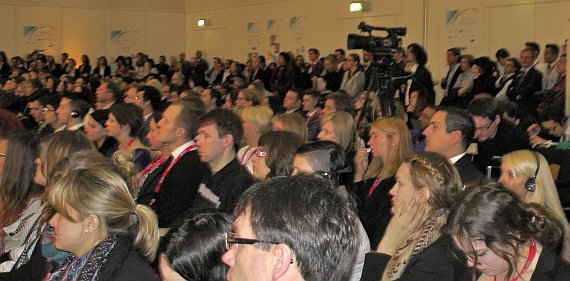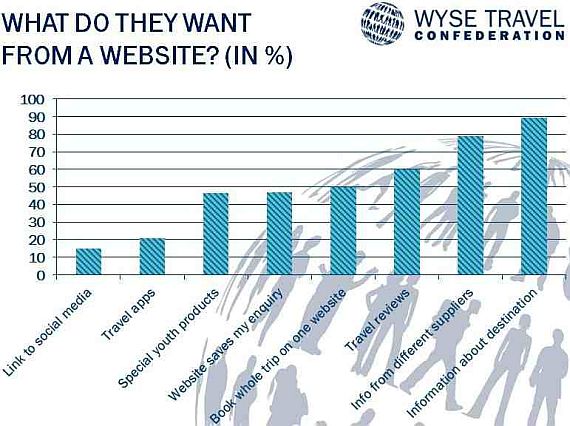ITB Hospitality Day about young travellers: they are hard to win over
 |
|
| Proving the boom: At the ITB Hospitality Day 2013, the session about young travellers attracted more than 500 visitors, a record of the day. |
Berlin (March 15, 2013). In the seventies of the 20th century, inter-rail trips were the ultimate travel experience for teens and twens from Europe; but today, cheap flights and hostels, youth trip operators and open borders offer even more thrilling perspectives. But what do the young travellers really want, which preparations are necessary for them, and what can hotels learn from hostels in this process? Last week, a panel discussion at the 8th "ITB Hospitality Day" in Berlin provided some answers.
The diversity of destinations where young tourists travel is increasing. Number one outside of Europe is still the US, but South America, the Caribbean, South East Asia, Australia, China, Japan or Africa are also in high demand. Young tourists often stay in hostels. Therefore, Greg Richards, Professor at Tilburg University, presented the latest results of the new global WYSE study "New Horizons" of WYSE Travel Confederation about this kind of accommodation and its guests.
Core target groups of the hostels are the 20 to 25-year olds. On their trips, young guests spend more money than average in the accommodation businesses (mostly about 600 euros, in Oceania 1,000 Euro). The prime reason is that they travel longer than others," explains Richards. The number of hostels is growing rapidly. In 2014, there will be 262 new hostels opening, according to a study. This is an increase of 12 percent compared to the previous year. Number one among the new openings are Spain and Brazil with 18 and 17 hostels respectively followed by the US, Peru, Malaysia, Great Britain, Argentina, Columbia, Italy and Thailand.
Contrary to the assumption of the hostel operators that the location of the hostel is the most important criterion for booking amongst young guests, the price is the most crucial factor followed by quality and the reputation of the hostel. For the trip planners, information about the destination, information of third parties as well as travel reports are important on the homepage. "This strengthens the importance of external online travel agents," said Richards.
 |
|
| Discussing young travellers' world: the student Hilmar zum Buttel, Carl Michel of Generator Hostels, Dirk Foeste of ruf Reisen, David Chapman of WYSE Travel Confederation and Greg Richards of Tilburg University. / photos (3): map |
Backpacker and flashpacker
Amongst the young hostel guests, about 40 percent are business guests as well as many older people remained young at heart. "The young traveller is becoming increasingly older. In the hostel in which I stay here in Berlin, most guests are as old as I am," said the expert at the ITB. According to Richards, so-called "flashpackers" stay in hostels apart from classical backpackers: flashpackers are (older) travellers who prefer a local connection but could actually afford other accommodation.
What do young travellers like so much about hostels? Carl Michel, CEO of Generator Hostels, provided several answers: "Hostels offer an experimental environment.
Hostels are the basis for social interaction and communication with other nationalities. The softness of a towel is not as important as who you meet there." Concerning the equipment, the public areas are very important with their chill out areas. Soft criteria like information about possible events are important too. At Generator, many events take place at the hostels, e.g. with artists or DJs. "Social events have been neglected by hosts for a long time," added Greg Richards. "Young people save their money for adventures. They spend 25 euros for the hostel and 80 euros for a bungee jump." Nevertheless, the hardware should not be neglected, added Carl Michel for consideration. "We are increasingly investing in design. Young guests don't just want a bed."
Guided youth trips are changing
Ruf Jugendreisen is specialised in trips for youths who no longer want to travel with their parents but do not want or are not allowed to travel on their own. 80,000 young people between the age of 10 and 30 travel with this tour operator every year. Core target group of the Ruf guests is the age group between 14 and 18. According to the Marketing Director Dirk Foeste, Ruf Reisen offers accompanied group trips with planned adventures.
The ideas of the youths are not always identical with those of the parents; therefore, the business carries out an extensive survey each year with more than 100 questions amongst 5,000 youths. "In addition, we look at successful trip models for adults and adapt them for young travellers," explained Foeste. This way, a club concept for children was developed, for example. Breakfast at 11 o'clock for youths who partied in the evening is another result. "In the internet era, the desires change constantly. The communication is digital," explained Foeste, travelling has become a social event. The exchange about the trip already starts long in advance when the youths form groups in the internet.
 |
|
| What do young travelers expect from a website? The graph shows their priorities. / Source: WYSETC |
How important are brands and loyalty?
But what about the brand loyalty amongst the youngsters? "Young people are interested in brands. Amongst other things, this is apparent on their Facebook pages. On average, they have 25 brands they like there," said Michel of Generator Hostels. "If a target group has been well taken care from the time of arrival to departure, it develops some brand loyalty."
David Chapman, Chairman of the Board of World Youth Students & Education (WYSE) Travel Confederation, also believes in brand awareness among the young guests. "The price is the strongest criterion, and then they look for a brand they recognise," he explained.
Hilmar zum Buttel, student in Bad Honnef and the only representative of the discussed target group on the podium, sees this differently. He plans his trips via Facebook; for him, recommendations from friends are more important than brands. Foeste of Ruf Reisen replied immediately: "Each brand finds it very difficult to bond with young people as they change so quickly. Younger people up to the age of 16 change their taste every year. A 16-year old does not want to have anything to do with the person he or she was one year before. One has to woo this target group again and again." In practice, this means that the brand has to change with the customer. However, brands do not change traditionally. Therefore, some brand businesses already have 25 logos for a product today.
Large market for hotels and hostels
The panel discussion also revealed that the travellers' transition from hostel to hotel and back is a smooth one. Chapman: "Products offered to young travellers also attract older people who are looking for the backpacking experience. And zum Buttel, who completed an internship at Kempinski during his studies, did not tire of praising the advantages of this business both as an employer as well as a guest. He knows hostels from his studies and has already stayed in one, but due to the perks he receives as an employee at Kempinski, he prefers to stay in the luxury hotels of the chain. According to Carl Michel, switching between Kempinski and hostels is not uncommon. "For this reason, we are constantly modifying our hostels," he explains. / Susanne Stauss
Watch the YouTube video about this ITB Hospitality Day 2013 session in full length – click here
To print this article you have to be registered and logged in for newsletter, visitor or subscription.





